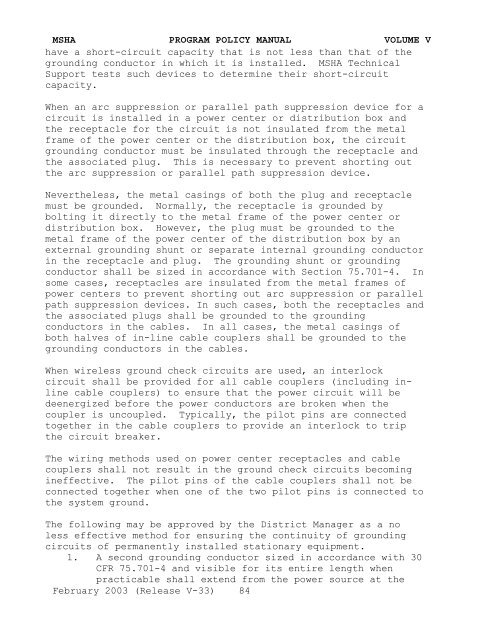Program Policy Manual - VOLUME V - Mine Safety and Health ...
Program Policy Manual - VOLUME V - Mine Safety and Health ...
Program Policy Manual - VOLUME V - Mine Safety and Health ...
You also want an ePaper? Increase the reach of your titles
YUMPU automatically turns print PDFs into web optimized ePapers that Google loves.
MSHA PROGRAM POLICY MANUAL <strong>VOLUME</strong> V<br />
have a short-circuit capacity that is not less than that of the<br />
grounding conductor in which it is installed. MSHA Technical<br />
Support tests such devices to determine their short-circuit<br />
capacity.<br />
When an arc suppression or parallel path suppression device for a<br />
circuit is installed in a power center or distribution box <strong>and</strong><br />
the receptacle for the circuit is not insulated from the metal<br />
frame of the power center or the distribution box, the circuit<br />
grounding conductor must be insulated through the receptacle <strong>and</strong><br />
the associated plug. This is necessary to prevent shorting out<br />
the arc suppression or parallel path suppression device.<br />
Nevertheless, the metal casings of both the plug <strong>and</strong> receptacle<br />
must be grounded. Normally, the receptacle is grounded by<br />
bolting it directly to the metal frame of the power center or<br />
distribution box. However, the plug must be grounded to the<br />
metal frame of the power center of the distribution box by an<br />
external grounding shunt or separate internal grounding conductor<br />
in the receptacle <strong>and</strong> plug. The grounding shunt or grounding<br />
conductor shall be sized in accordance with Section 75.701-4. In<br />
some cases, receptacles are insulated from the metal frames of<br />
power centers to prevent shorting out arc suppression or parallel<br />
path suppression devices. In such cases, both the receptacles <strong>and</strong><br />
the associated plugs shall be grounded to the grounding<br />
conductors in the cables. In all cases, the metal casings of<br />
both halves of in-line cable couplers shall be grounded to the<br />
grounding conductors in the cables.<br />
When wireless ground check circuits are used, an interlock<br />
circuit shall be provided for all cable couplers (including inline<br />
cable couplers) to ensure that the power circuit will be<br />
deenergized before the power conductors are broken when the<br />
coupler is uncoupled. Typically, the pilot pins are connected<br />
together in the cable couplers to provide an interlock to trip<br />
the circuit breaker.<br />
The wiring methods used on power center receptacles <strong>and</strong> cable<br />
couplers shall not result in the ground check circuits becoming<br />
ineffective. The pilot pins of the cable couplers shall not be<br />
connected together when one of the two pilot pins is connected to<br />
the system ground.<br />
The following may be approved by the District Manager as a no<br />
less effective method for ensuring the continuity of grounding<br />
circuits of permanently installed stationary equipment.<br />
1. A second grounding conductor sized in accordance with 30<br />
CFR 75.701-4 <strong>and</strong> visible for its entire length when<br />
practicable shall extend from the power source at the<br />
February 2003 (Release V-33) 84
















